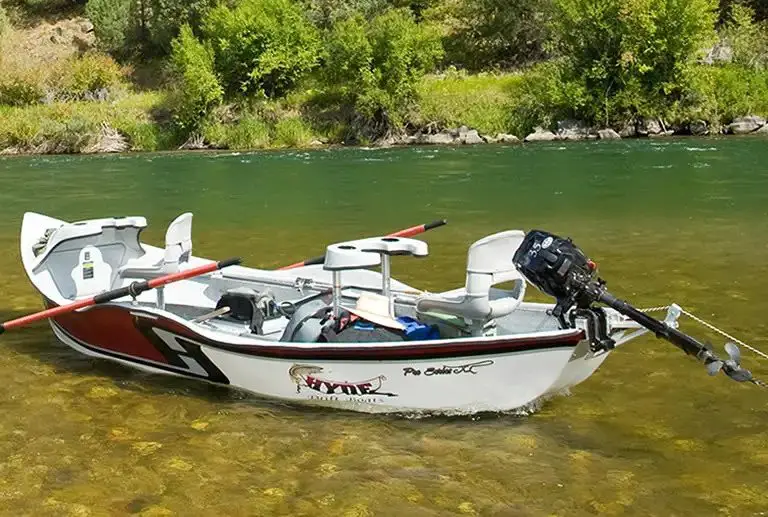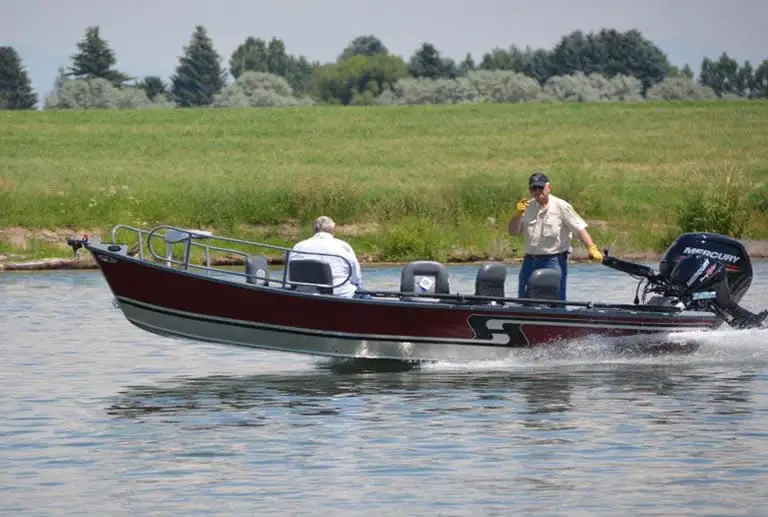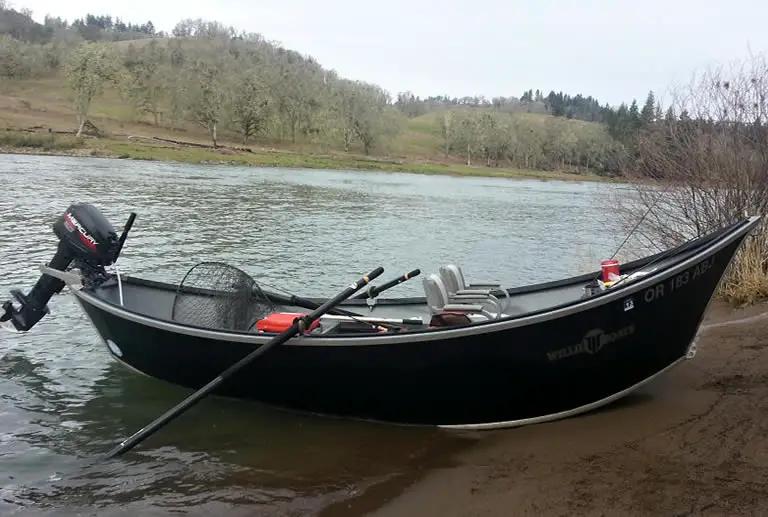Contents
- Guide To Using A Drift Boat With A Motor Fitted
- Can You Put a Motor on a Drift Boat?
- How a drift boat reacts negatively to motor thrust
- Low HP trolling motors are safest to fit & use on drift boats
- Remember fitting a motor on a drift boat is not about speed, it’s about propulsion
- The best type and size of motor for a drift boat
- Drift boat with motor fitted in action(video)
- Fast drift boat with motor (video)
- Summary: The Advantages & Disadvantages Of A Drift Boat Motor
Guide To Using A Drift Boat With A Motor Fitted
Below I highlight how you can attach an outboard motor to a drift boat.
I outline the best type of motor to use on a drift boat. It is vitally important you pay attention this information as fitting the wrong type of motor can be dangerous as you will see.
Can You Put a Motor on a Drift Boat?
Yes, you can put a motor on a drift boat but you need to be careful with the power.
A drift boat is a dory which was designed to be rowed by oars before outboard motors existed, so it is not an ideal candidate for using an outboard motor.

A high HP motor will send a drift boat into the banks quickly.
It is generally accepted that a low thrust, low speed (low HP) motor is best for a drift boat.
How a drift boat reacts negatively to motor thrust
A drift boat is an inland watercraft that is built around the basic hull design of an ocean dory.
It is designed to be used with oars which provide thrust from the center of the boat. This design characteristic of a drift boat means it doesn’t react well to thrust from the rear.
When you use outboard motor on a drift boat the thrust tends to push the transom down toward the water and the more thrust you apply the worse it gets.
Most drift boats have a flat-bottom with no keel.
They also have lots of rocker and these combinations mean the boat reacts poorly to the instant acceleration generated from thrust at the back of the boat.
The thrust generated from a powerful motor will make a drift boat extremely difficult, or even impossible, to control.
Thrust generated from a powerful engine will easily send a drift boat completely out of control.
If a drift boat is fitted with a powerful HP motor and the operator attempts to generate fast acceleration the boat will probably be sent into the lake banks.
Some manufacturers tried to deal with this problem in innovative ways. ClackaCraft, for example, once built a short, square-ended Rapid Robert styled drift boat (with a larger flat transom) that was fitted with fixed-wing trim tabs on it.
These trim tabs were little fiberglass wings that helped to counteract the tendency of the outboard motor to draw the transom down when in operation. Unfortunately, the boat is no longer in production.
If you want to use a higher HP motor on your drift boat than those mentioned in this article, and are handy at DIY, then you may want to buy and fit fixed-wing trim tabs to your own boat.
Low HP trolling motors are safest to fit & use on drift boats
Because drift boats do not react well to thrust it is best to only fit an outboard motor with low HP.
A low HP engine will ensure you can’t, even accidently, generate the type of thrust that would send your boat into the banks or nearby obstacles.
The lower the HP the better. Although this will mean slow speeds keep in mind that a drift boat is a rowboat and is not designed for speed.
Remember fitting a motor on a drift boat is not about speed, it’s about propulsion
Using a motor on a drift will not give you very much extra speed – if it gives you any at all.
The reason many drift boat owners fit a motor to their vessels is to reduce the amount of physical effort required to move the boat.
Fitting a motor to your drift won’t give you extra speed but it will eliminate the need to use physical effort when moving your boat upstream.
An outboard motor is used as a replacement for rowing.
You can allow a motor to do the bulk of the work involved with moving your boat and this is the only reason to fit an outboard motor to a drift boat.
The best type and size of motor for a drift boat
Because a drift boat reacts poorly to thrust large HP motors do not work well on them.
However, because the boat is fairly large a very weak HP motor may not be enough to move the boat against currents. So, when it comes to motor power you need to compromise.
For a drift boat it is best to use an electric motor because it has lower thrust than its gas-powered counterpart and is also lighter in weight.
Some drift boat owners will use a weak electric motor with very low HP for their drift boats so let’s look at the benefits and drawbacks to using this type of outboard.
The benefits of a very low HP electric motor
3 HP electric motors are more than powerful enough to move the boat downstream at similar speeds to rowing and will not generate too much thrust at the transom.
This type of small HP electric motor weighs very little so it won’t push down the stern of the boat and in addition, the battery that powers the motor can be stowed anywhere in the boat to better distribute weight.

Another benefit of using a low HP electric motor is that they are very quiet compared to a gas-powered engine.
The boat is also fairly easy to handle when using a low HP engine – handling a drift boat when using an outboard motor is a real concern as you will learn later.
The drawbacks to using a very low HP electric motor
Although a very low HP electric motor, like a 3 HP one, is more than enough to push your boat downstream it will struggle to move it upstream against the current.
Let’s face it a 3 HP motor isn’t very powerful.
The advantages you get from low thrust and low weight come at the cost of power. A 3 HP motor will not be powerful enough to push for an average sized drift boat against the current. So what is the alternative?
The advantages of higher HP electric motors
As we have seen a small electric 3 HP motor offers a drift boat owner many advantages. However, though it may be enough to power your boat downstream it will be ineffective against current when going upstream.
Obviously to move the boat against the current you will need to fit a higher HP motor. But, we have seen that high HP motors will send a drift out of control very quickly and probably force it into the banks. So, what is the solution?
Well, it is possible to fit a higher HP motor to a drift boat as long as you are careful about the type of motor you fit and, of course, its power.
An electric 10 HP motor has enough power to move a large drift boat upstream but is low enough in thrust to ensure the boat remains easy to handle.
10 HP motors will work well with drift boats that are 16′ +. For smaller drifts boats it is best to stay at, or below, 6 HP.
Using a 6 – 10 HP motor will still need some getting used to as powering a drift boat is not the same as other inland craft, such as a Jon boat, flat-bottomed skiff or even a canoe.
So take it easy in the beginning and be prepared to invest the time needed to develop the new skill of steering your boat under motorized power.
The disadvantages of higher HP electric motors
Higher HP motors require a little adjustment in your handling of a drift boat. As we outlined above drift boats do not have a hull design that is suited to motorized propulsion even though people do fit outboard motors to them.
Because higher HP motors generate more thrust, the back-end of your boat, the transom, will tend to be pushed down when the engine is engaged. At this point the steering of your boat will become much more difficult.
There is a definite learning curve to using an outboard motor on a drift boat and the bigger the engine the more control you need to learn.
Don’t be fooled into thinking you can make the jump to a higher HP motor for extra speed.
That increase in engine size will also result in an increase in weight, thrust and rocker.
These three things combined will actually cause slower speeds and result in it being more difficult to control your boat.
You should not go above a 10 HP motor on a drift boat.
Remember as well that you won’t get any extra speed from an increase in HP.
If you want extra speed you need a much more powerful motor. Unfortunately though, the type of motor that would increase the speed of your drift boat would make it almost impossible to steer the boat and would therefore be useless in the long run.
You need to be especially careful about using an outboard motor on a drift boat in choppy water.
If you need to know how to mount an outboard motor on a drift boat read these instructions.
Drift boat with motor fitted in action(video)
Fast drift boat with motor (video)
Summary: The Advantages & Disadvantages Of A Drift Boat Motor
Drift boats are not designed to be powered by a motor.
The hull design of this inland dory lends itself best to manual propulsion by oars.
Fitting a motor that is too powerful will result in a serious reduction in control over the boat. Steering will be difficult and the motor thrust can cause the boat to be pushed into the banks.
However, drift boat owners have successfully fitted small outboard trolling motors to their boats to make moving upstream easier.
The key to fitting an outboard motor to a drift boat is to keep the HP of the motor low.
Drifts boats above 16′ can be powered by a 10 HP electric outboard motor. Smaller drift boats should use 3 HP – 6 HP electric outboard motors.
You should also consider attaching fixed-wing trim tabs to your drift boat to help counteract the tendency of the outboard motor to draw the transom down when in operation.

